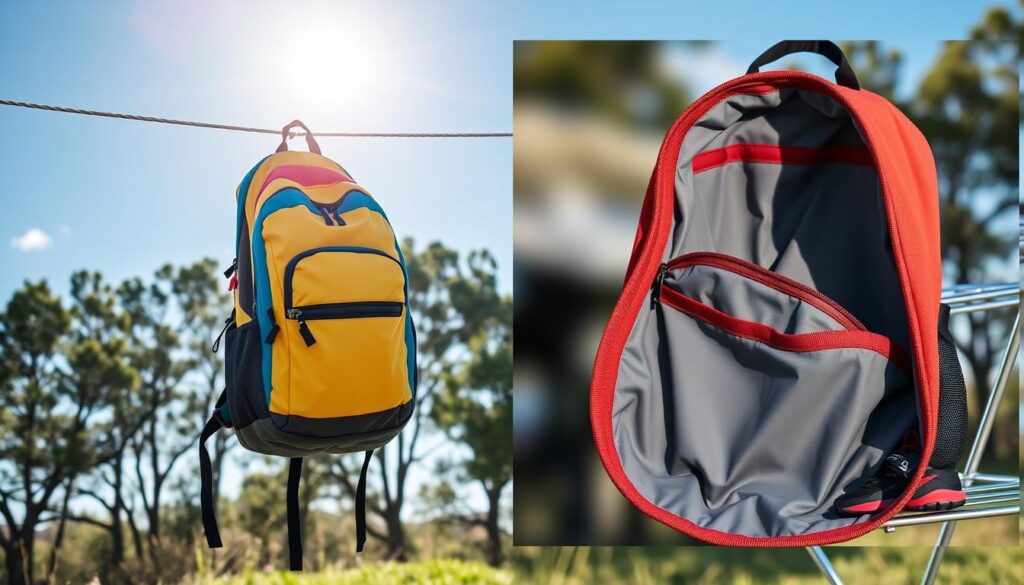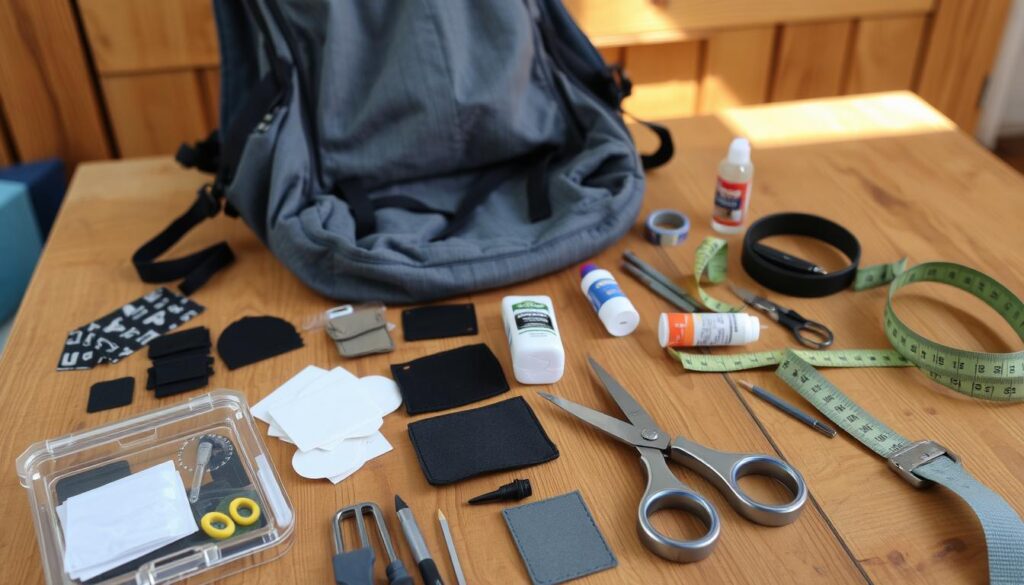Did you know 78% of backpack owners never wash their bags? This could mean millions of bacteria are living in them. It’s clear that backpack care and cleaning are key. Washing your backpack is important, but drying it right is just as crucial for its life and use.
Backpacks pick up dirt, sweat, and smells from daily use. They’re often made of tough materials like nylon, polyester, or canvas. These can handle machine washing. But, drying them in the dryer is a different story. It can cause serious damage1.
Inside your backpack, you’ll find care labels with washing instructions. It’s important to follow these to keep your bag safe. While machine washing is okay for some materials, drying needs extra care1.
Hand washing is usually the safest choice, especially for backpacks with special coatings or designs. This method cleans well without harming the fabric or any extras1.
Cleaning your backpack regularly, like once or twice a year, keeps it looking good and smelling fresh. But, gym bags used as backpacks might need washing more often because of sweat. Backpacks for outdoor activities should be cleaned after each trip2.
Key Takeaways
- Most backpacks should not be put in the dryer
- Follow care label instructions for proper washing
- Hand washing is the safest cleaning method
- Regular cleaning maintains backpack quality
- Air drying is recommended for most backpacks
- Frequency of cleaning depends on backpack use
Understanding Backpack Materials
Knowing what your backpack is made of is crucial for keeping it in good shape. Each material has its own needs when it comes to cleaning.
Common Fabrics Used in Backpacks
Backpacks are made from many materials, each with its own benefits. Nylon and canvas are favorites for their toughness. Nylon backpacks can usually be washed in a machine, making them simple to clean2. Canvas bags, though strong, might need more care when cleaning.
Durability and Care Requirements
Every backpack material has its own cleaning needs. Nylon and polyester are often water-resistant and long-lasting. Canvas might need a gentler cleaning approach. Leather backpacks, on the other hand, require special cleaners or conditioners2.
For backpacks with special coatings or decorations, hand washing is safest. This method helps keep the bag’s unique features intact1. Taking good care of your backpack can save you money over time.
If you’re unsure about your backpack’s material or how to clean it, always check the label. It’s your best resource for keeping your bag looking and feeling great. Regular cleaning and storing it in a dry, well-ventilated spot can prevent bad smells and mold, keeping your backpack in excellent shape2.
Reasons Against Using the Dryer
Backpack owners should be careful when it comes to drying. Putting your backpack in the dryer might seem quick, but it can harm it a lot.
Heat Damage Risks
Dryers use high heat that can damage your backpack. It can shrink fabrics and melt synthetic parts. Even UV rays from sunlight can weaken the fabric over time.
The dryer’s heat can make this damage worse. It can also ruin the protective coatings on your backpack3.
Structural Integrity Concerns
The dryer’s tumbling action can harm your backpack’s structure. It can damage padding, seams, and straps. This can cause your backpack to wear out faster4.
Backpack frames and support systems aren’t made to be taken apart for cleaning. Trying to put them back together after washing can cause permanent damage4.
| Dryer Risks | Potential Damage |
|---|---|
| High Heat | Fabric shrinkage, melting of synthetics |
| Tumbling Action | Compromised padding, seam damage |
| Prolonged Exposure | Degradation of waterproof coatings |
To keep your backpack in good shape, air drying is best4. Dry it in a cool, dry place with all zippers open. This keeps your backpack looking and working great4.

Alternatives to Drying in the Dryer
Air drying is the safest way to dry backpacks. It keeps the fabric and structure in good shape. Let’s look at some ways to air dry backpacks and other dryer alternatives.
Air Drying Techniques
Air drying is the safest option for most backpacks5. To air dry your backpack:
- Hang it upside down in a well-ventilated area
- Open all zippers and compartments
- Stuff with towels to absorb excess moisture
- Rotate the backpack periodically for even drying
For outdoor drying, choose a shaded area to prevent fabric fading. Make sure your backpack is completely dry before use to avoid mold and mildew growth.
Using a Fan or Dehumidifier
To speed up the drying process:
- Place a fan near your backpack to circulate air
- Use a dehumidifier in the room to reduce moisture
These methods can make drying faster while still being safe. Remember, high heat can damage certain backpack materials, so always choose gentler drying methods5.
| Drying Method | Pros | Cons |
|---|---|---|
| Air Drying | Safest for all materials | Takes longer |
| Fan-Assisted | Faster than air drying | May need repositioning |
| Dehumidifier | Effective in humid climates | Higher energy usage |
By following these backpack air drying techniques, you’ll extend the life of your backpack and maintain its quality for years to come.
Preparing Your Backpack for Washing
Getting your backpack ready for washing is essential for its longevity. Before you start, do some pre-wash care to get the best results.
Emptying and Inspecting Your Backpack
First, empty all pockets and compartments. Take out loose items, crumbs, and dirt. Use a vacuum or soft brush for tough dirt.

Then, check your backpack for stains or spots needing extra care. Use a mild detergent solution to treat these areas before washing. Mild detergent and lukewarm water are best for cleaning stains and dirt1.
Detachable Components: What to Remove
Take off any parts that can be removed. This includes:
- Metal frames
- Removable straps
- Hip belts
- Accessories like keychains
Removing these items protects them from damage and lets you clean the main body better. It’s best to wash your backpack alone to avoid damage from other items6.
“A clean backpack is a happy backpack. Take the time to prepare it right, and it’ll thank you with years of faithful service.”
Most backpacks are made from durable materials like nylon, polyester, or canvas, safe for machine washing6. But always check the care label inside for specific washing instructions1. With the right preparation and care, your backpack will come out clean and ready for more adventures.
| Cleaning Frequency | Recommended Cleaning Method | Drying Method |
|---|---|---|
| 1-2 deep cleanings per year | Machine wash (gentle cycle) or hand wash | Air dry (1 day or longer) |
Recommended Washing Methods
Keeping your backpack clean is key for its life and your health. We’ll look at the best ways to wash your backpack. This will keep it fresh and working well.
Machine Washing vs. Hand Washing
Most backpacks made from canvas or nylon can be machine washed7. But, hand washing is softer and better for delicate or special backpacks. For machine washing your backpack, use 1-2 tablespoons of mild detergent in cold water7.
Hand washing needs lukewarm water and gentle soap. Use a soft brush for light scrubbing.
Ideal Water Temperatures
Use cold or lukewarm water for both machine and hand washing7. Hot water can harm fabrics and coatings. For tough stains, mix equal parts liquid detergent and water. Let it sit for 30 minutes before washing7.
“Always check the care label for specific washing instructions tailored to your backpack’s material.”
| Washing Method | Water Temperature | Detergent Amount |
|---|---|---|
| Machine Wash | Cold | 1-2 tablespoons |
| Hand Wash | Lukewarm | Small amount |
Washing too often can wear down protective coatings8. For North Face backpacks, vinegar can help with stains. Then, wash in cool water with a low spin cycle8. Always dry your backpack outside or in a well-ventilated area. Avoid direct heat and sunlight to keep its shape and quality8.
Cleaning Supplies You’ll Need
Getting your backpack cleaning supplies ready is key for keeping it clean and maintained. The right tools and care can make your backpack last longer. Let’s look at the best detergents and cleaning tools to keep your backpack in great shape.
Best Detergents for Backpack Care
Use mild, fragrance-free detergents to protect your backpack’s materials. For nylon backpacks, a delicate cycle in the washing machine works well9. Tide Hygienic Clean Liquid Laundry Detergent, available at $15 at Lowe’s, is a great choice for deep cleaning10. For tough stains or mold, Clorox® Disinfecting Bleach can help, but test it first to avoid color changes9.
backpack washing instructions
Proper maintenance of your backpack can significantly extend its lifespan and keep it looking fresh. Before diving into the backpack washing instructions, it’s essential to check the care label typically found inside the bag. Different materials require different cleaning methods, so understanding the specific backpack material care will help you avoid damage. Most backpacks are made of nylon, polyester, or canvas, and each of these materials has unique characteristics and cleaning needs.
For general cleaning, it’s advisable to empty your backpack of all contents and shake it out to remove any loose dirt or debris. If your backpack has removable storage compartments, take them out and wash them separately. To spot clean, use a damp cloth and a mild detergent to tackle any stains or dirt. For a more thorough cleaning, you can hand wash your backpack in a bathtub or large basin filled with lukewarm water. Use a soft brush or cloth to scrub gently, ensuring that you don’t damage any zippers or hardware.
If you’re dealing with a particularly dirty bag, some backpacks can be machine washed, but ensure you follow the specific backpack washing instructions. Use a gentle cycle with cold water, and place your backpack inside a laundry bag or between pillows for added protection. Avoid using bleach or fabric softeners, as these can break down the materials. Air drying is the best option after washing; lay it flat or hang it to dry, but avoid direct sunlight to prevent fading.
Lastly, regular maintenance is just as important as cleaning. Periodically check for wear and tear, repair any small rips and clean your backpack after extensive use or exposure to dirt and moisture. By adhering to these backpack washing instructions and practicing proper backpack material care, you can ensure your gear remains functional and stylish for years to come.
Tools for Spot Cleaning
Have these backpack cleaning supplies ready for quick clean-ups:
- Soft-bristled brush or old toothbrush
- Sponge
- Gentle stain remover
- Microfiber cloth
For fast sanitizing between washes, Clorox® Disinfecting Mist is perfect9. The E-Cloth Microfiber Cleaning Cloth, available at $13 on Amazon, is great for gentle cleaning10. For leather backpacks, Weiman Leather Cleaner and Conditioner, priced at $18 on Amazon, is the best choice10.

| Product | Price | Use |
|---|---|---|
| Dawn Dish Soap (3-Pack) | 19% off | Gentle spot cleaning |
| Tide Antibacterial Fabric Spray | 45% off | Quick disinfecting |
| Lysol Disinfecting Wipes | $7 on Amazon | Surface cleaning |
Remember, a thorough cleaning is needed once or twice a year. But, clean more often for kids’ backpacks or those used for gym clothes11. Regular use of these supplies will keep your backpack clean and extend its life.
Drying Your Backpack Safely
After washing your backpack, it’s important to dry it right. This keeps its shape and stops damage. We’ll look at the best ways to air dry your backpack and where to do it.
Best Practices for Air Drying
Air drying is the safest way to dry your backpack. Don’t use a dryer as it can shrink and damage nylon straps2. Gently squeeze out water without wringing it. Open all zippers and compartments for air to get in.

Recommended Locations for Drying
Find a place with good air flow to dry your backpack. Drying outside can get rid of smells, but watch out for sunlight that might fade colors. If you dry it inside, a fan or dehumidifier can help.
It might take a day for a backpack to dry because it’s thick2.
For the best results, follow these tips:
- Rotate the backpack to dry evenly
- Use a clothesline or drying rack to keep its shape
- Don’t store the backpack until it’s completely dry to avoid mold
Be patient when drying your backpack. It might take a day or more, depending on the fabric and where you are6. After it’s dry, you can use a waterproofing spray if it’s right for your backpack’s material6. By doing this, your backpack will last for many years.
machine drying backpacks
When it comes to maintaining the longevity of our backpacks, one often overlooked aspect is the drying process after a wash. After an adventurous day filled with outdoor activities or a long commute, our backpacks can accumulate dirt, moisture, and odors that require a thorough cleaning. However, once they are washed, the method we choose for drying them can significantly impact their overall condition. This leads us to an important question: can you put a backpack in the dryer? The answer is not a simple yes or no; it depends on the materials and construction of the backpack.
Machine drying backpacks can be tempting for those looking for a quick and efficient way to dry their gear. However, many backpacks come equipped with delicate materials, waterproof coatings, or intricate features like padding and buckles that may not withstand the high heat of a dryer. Using a dryer can also lead to potential deformities or fabric damage, which could affect both functionality and aesthetics. Instead, proper backpack drying methods involve air-drying, which allows the materials to maintain their original structure while thoroughly eliminating moisture.
To ensure proper backpack drying without risking damage, it’s advisable to start by emptying the pack and wiping down any remaining dirt. Additionally, unzipping all compartments will aid in airflow during the drying process. Hanging the backpack upside down or on a sturdy clothesline can expedite the drying process and prevent water from pooling in pockets. If time is of the essence, using a fan or placing the backpack in a well-ventilated area can help speed up drying without exposing it to the harsh conditions of machine drying.
Overall, while the convenience of machine drying backpacks might seem appealing, opting for proper backpack drying techniques will extend the life of your gear. Protecting the investment you’ve made in your backpack ensures that it remains functional, looking great, and ready for your next adventure. With a little patience and the right approach to drying, you can keep your backpack in prime condition for years to come.
Maintaining Your Backpack’s Longevity
Keeping your backpack in good shape is important. A few simple steps can help your backpack last for years.
Preventive Measures After Washing
It’s important to dry your backpack right after washing. Air drying is the best way to avoid damage12. Use a microfiber towel to wipe it down. Leave zippers open and hang it upside down, away from sunlight13.
Regular Maintenance Tips
Regular cleaning and stain treatment are key to keeping your backpack in good condition13. For tough stains, mix 70% isopropyl alcohol, water, and dish soap13. Always check the care label before cleaning to use the right method12.

Here’s a quick guide to help you maintain different types of backpacks:
| Backpack Material | Cleaning Method | Drying Method | Special Care |
|---|---|---|---|
| Canvas | Hand wash or machine wash | Air dry | Apply waterproof spray |
| Nylon | Machine wash in laundry bag | Air dry | Use gentle detergent |
| Leather | Wipe with damp cloth | Air dry | Apply leather conditioner |
| Polyester | Hand wash or machine wash | Air dry | Pre-treat stains |
Regular maintenance not only keeps your backpack clean but also extends its life. By following these tips, your backpack will stay in great shape for many adventures.
What to Do if Damage Occurs
Knowing how to fix your backpack is key for outdoor lovers. Spotting and solving problems can save you a lot of time and money. Let’s look at common backpack issues and how to fix them.
Identifying Common Issues
Watch out for these common backpack problems:
- Torn seams
- Broken zippers
- Worn straps
- Fabric tears
Regular checks can catch these problems early. About 25%-30% of people wash their backpacks once or twice a year. This is a great time to look for damage14.

Repair Solutions for Minor Damage
For small tears, use fabric patches or strong glue. If a zipper breaks, replace it or get it fixed by a pro. Strengthen worn straps with extra stitching. These easy fixes can make your backpack last longer.
When washing your backpack, be careful. Washing machines can harm the material and the PU coating over time15. Most people prefer hand washing with a mild, non-bleach detergent14.
For bigger damage, think about getting it professionally fixed. If your backpack has leather (about 10%-15% do), it might need special care or leather conditioners after washing14.
“Prevention is better than cure. Regular maintenance can prevent many common backpack issues.”
Remember, drying your backpack right after cleaning or repair is key. It takes 1-2 days for a backpack to dry fully. Proper drying stops damage1415. With these tips, you’ll be ready for backpack repair and upkeep.
When to Consult the Manufacturer’s Guidelines
It’s important to know when to look at the manufacturer’s guidelines for backpack care. General cleaning tips are good, but your backpack’s materials and design might need special care.
Importance of Following Care Instructions
Different backpack materials need different care. Nylon or canvas backpacks can be machine washed. But, those with leather trim should not be2. For leather backpacks, use a quality leather cleaner instead of soap and water2. Always check the care label inside your backpack for specific instructions.
Contacting Customer Support for Advice
If you’re unsure about backpack care instructions, reach out to the manufacturer’s customer support. They can give you tailored advice for your backpack model. This is especially important for high-end or specialized backpacks with unique features or materials.
Remember, proper care extends your backpack’s life. Wash backpacks once or twice yearly, more often for exercise or outdoor use2. Quick interior cleans every two weeks keep your backpack fresh between washes2. By following these backpack manufacturer guidelines and care instructions, you’ll keep your gear in top shape for years to come.
backpack washing instructionsWhen it comes to backpack care, many people find themselves needing to reach out to customer support for advice. A common question that arises is, “Can you put a backpack in the dryer?” It’s understandable to wonder about the best ways to maintain the integrity of your gear while ensuring it stays fresh between washes. Customer support can provide you with specific recommendations based on the materials and construction of your backpack, which can be vital to preserving its longevity.
The practice of backpack drying can often lead to confusion, especially when it comes to methods of drying. Some might consider backpack tumble drying as a quick solution, but this may not be advisable for all types of backpacks. Fabric care labels often indicate safe drying methods, such as air drying or using a low heat setting, but contacting customer support can offer additional insights that are tailored to your specific backpack model. For example, they might recommend avoiding heat altogether for certain materials, which can help prevent damage.
It’s always a good idea to consult the experts when unsure about your backpack maintenance. Engaging with customer support can not only clarify your questions about drying methods but also provide other useful tips for keeping your backpack in top shape. Whether you need guidance on washing, drying, or general upkeep, reaching out to the brand can offer peace of mind and ensure that you’re following best practices. Ultimately, following the care instructions provided by the manufacturer along with the advice from customer support can keep your gear looking fresh and performing well for years to come.
FAQ
Can you put a backpack in the dryer?
What’s the best way to dry a backpack after washing?
How often should I wash my backpack?
Can I machine wash my backpack?
What’s the best way to remove stains from my backpack?
How do I prepare my backpack for washing?
What kind of detergent should I use to wash my backpack?
How long does it take for a backpack to air dry?
How can I maintain my backpack’s longevity?
What should I do if my backpack gets damaged?
Source Links
- How to Wash a Backpack in 5 Steps | Whirlpool – https://www.whirlpool.com/blog/washers-and-dryers/how-to-wash-a-backpack.html
- 3 Easy Ways to Wash a Backpack to Keep It Brand New – https://www.realsimple.com/home-organizing/cleaning/how-to-wash-a-backpack
- How to Wash a Backpack – https://www.backpacker.com/skills/how-to-wash-a-backpack/
- How to clean a backpack – https://www.deuter.com/us-en/advice/how-to-clean-a-backpack
- Can You Put Backpacks In The Dryer: A Comprehensive Guide – Dryers Hub – https://dryershub.com/clothes-dryer/drying-clothes/can-you-put-backpacks-in-the-dryer/
- How to Wash a Backpack in 5 Steps | Maytag – https://www.maytag.com/blog/washers-and-dryers/how-to-wash-a-backpack.html
- How to Wash a Backpack (With Pictures) – https://www.wikihow.com/Wash-a-Backpack
- How to Wash a North Face Backpack? – https://www.apparelnbags.com/blog/how-to-wash-a-north-face-backpack/?srsltid=AfmBOoppFLwP0IlVv4_hYH-sSp8Lf3Ck_9EDFOp81l0OXeEA_Rko6KIS
- How to Wash & Sanitize a Backpack, and Remove Mold | Clorox® – https://www.clorox.com/learn/how-to-clean-and-sanitize-a-backpack/
- How to Wash a Backpack in Just a Few Easy Steps – https://www.goodhousekeeping.com/home/cleaning/a35049399/how-to-wash-a-backpack/
- How to Wash a Backpack Without Ruining It In Just a Few Easy Steps – https://www.thespruce.com/how-to-wash-a-backpack-8672195
- How to Wash a Backpack | Backpacker Boy – https://www.backpackerboy.com/how-to-wash-a-backpack/
- Clean That Up | The Right Way to Clean A Backpack – https://www.letscleanthatup.com/the-right-way-to-clean-a-backpack-a-step-by-step-guide/
- How to Wash a Backpack: The Do’s and Don’ts – https://www.stitchfix.com/women/blog/fashion-tips/how-to-wash-a-backpack/?srsltid=AfmBOoqmGFXB9Ag17Duru6fEDgrvFo5_pRGQBCGTD8zMTCcOK6j8cw7M
- How to clean a backpack – https://www.deuter.com/int-en/advice/how-to-clean-a-backpack